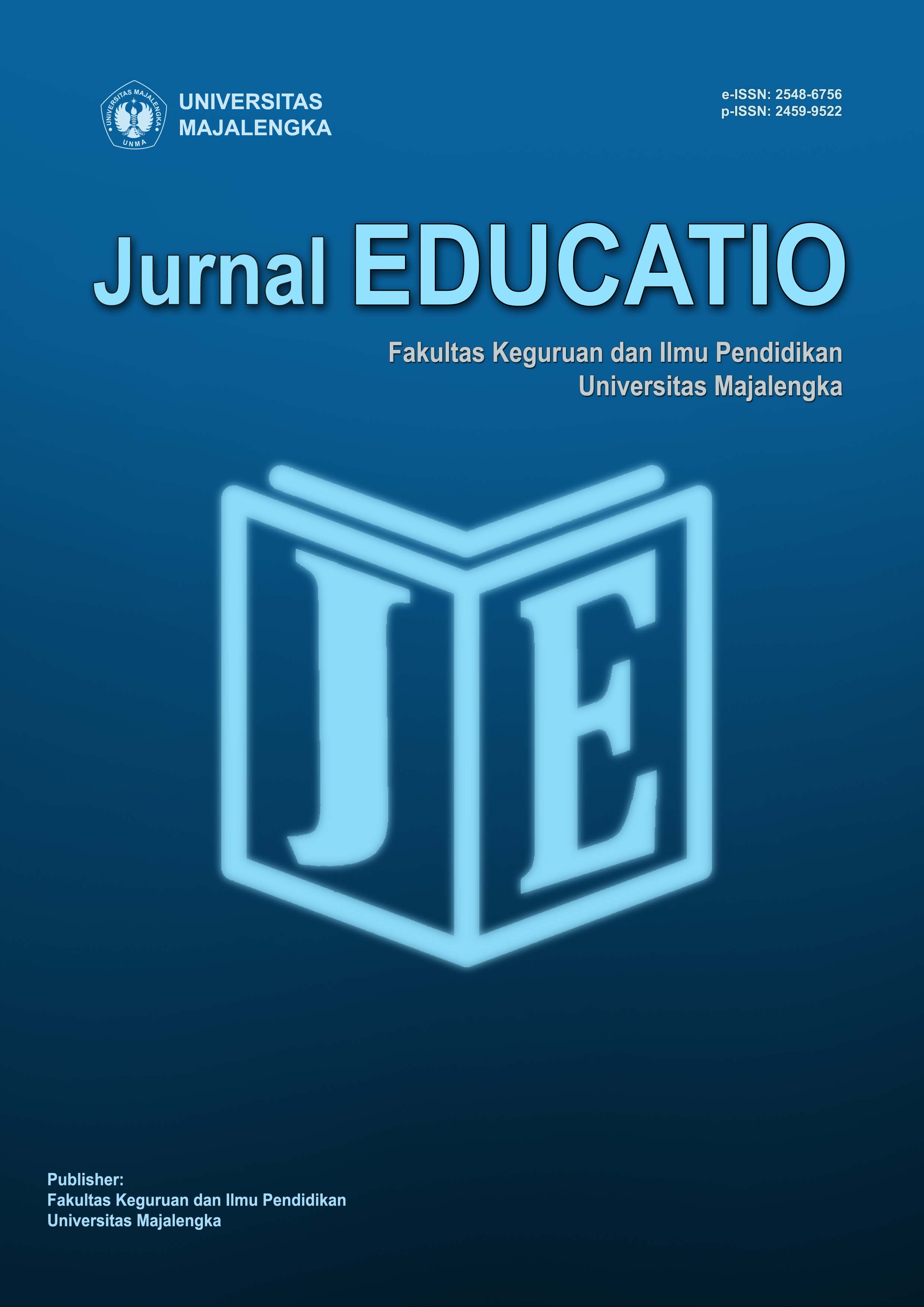Implementation of Phase F Learning in Kurikulum Merdeka
How Well Students Able to Analyze Text?
DOI:
https://doi.org/10.31949/educatio.v11i1.10431Abstract
"Kurikulum Merdeka" allows teachers to choose the material they find necessary to teach in class. Phase F is a learning phase for grades 11 and 12 at vocational/senior high schools, with the final learning outcome that students should have standard competence in spoken, written, and visual English to communicate according to the situation, purpose, and audience/reader. In this phase, various texts can be used as the main learning material, as they can help students improve their vocabulary, grammar, interpretation, and ability to analyze and produce texts. However, many students face challenges with their basic English skills. A study was conducted to assess students' abilities in analyzing text, specifically analytical exposition texts. Fourteen students majoring in software engineering were involved in the qualitative descriptive study, and data was collected through observation and assessment. Students were required to analyze the text and record it as videos, aiming to increase their technological literacy through mastery of various applications such as Bandicam.The research findings revealed that students showed very good ability in analyzing the generic structure of the text, but struggled with analyzing language features like simple present tense, conjunctions, and terms related to the context. On the positive side, students demonstrated strong technological literacy as they were able to master various video-making applications.
Keywords:
phase F, kurikulum merdeka, text, analyze, analytical expositionDownloads
References
Anderson, M. and Anderson, K. (1997). Text Types in English I. South Yarra: Machmillan Education Malaysia
Ary et al. (2010). Introduction to Research in Education. 8 th edn. Belmont, CA: Wadsworth.
Brown, H. D. (1994). Teaching by principles. Englewood Cliffs, NJ: Prentice Hall.
Brown. H. D. (2004). Language Assessment: Principles and Classroom Practices. Longman
Benson, P. (2011). Teaching and researching autonomy (2nd ed.). London & New York: Routledge.
Bradford, A. (2007). Motivational orientations in under-researched FLL contexts: Findings from Indonesia. RELC, 38(3), 302-323.
Cendekia, C. A., Dhariyanti, D., Barlanti, K. N. Q., Primasari, F. A., Utomo, A. P. Y., & Nurmalisa, D. (2023). Analisis Kalimat pada Teks Biografi dalam Buku Cerdas Cergas Berbahasa dan Bersastra Indonesia untuk SMA/SMK Kelas X Kurikulum Merdeka. Jurnal Motivasi Pendidikan dan Bahasa, 1(1), 140-157.
Chan, V. (2001). Readiness for learner autonomy: What do our learners tell us? Teaching in Higher Education, 6(4), 505-518.
Cirocki, A., Anam, S., & Retnaningdyah, P. (2019). Readiness for autonomy in English language learning: The case of Indonesian high school students. Iranian Journal of Language Teaching Research, 7(2), 1-18.
Creswell, J. (2003). Research design: Qualitative, quantitative, and mixed methods approaches (2nd ed.). Thousand Oaks, CA: Sage.
Derewianka, B. (2011). A new grammar companion for teachers. Primary English Teaching Association.
Emilia, E. (2012). Pendekatan Genre-Based dalam Pengajaran Bahasa Inggris: Petunjuk untuk Guru. Bandung: Rizqi Press.
Fang, Z., & Schleppegrell, M. J. (2008). Reading in secondary content areas: A language-based pedagogy. University of Michigan Press.
Fitriani, R. C., Anita, F., Putra, M. I. R., & Hafis, M. (2022). AN ANALYSIS OF STUDENTS’READINESS FOR AUTONOMOUS LEARNING OF ENGLISH SUBJECT. Journal of English Language Teaching and Education (JELTE), 3(2), 103-114.
Gibbons, P. (2015). Scaffolding language, scaffolding learning: Teaching English language learners in the mainstream classroom (2nd ed.). Heinemann.
Halliday, M. A. K., & Matthiessen, C. M. I. M. (2014). Halliday's introduction to functional grammar (4th ed.). Routledge.
Hyland, K. (2004). Genre and second language writing. University of Michigan Press.
Knapp, P., & Watkins, M. (2005). Genre, text, grammar: Technologies for teaching and assessing writing. University of New South Wales Press.
Kustini, T. (2023). Mapping The Readiness Of Students In Learning English Phase F Of The Independent Curriculum. Buletin Ilmiah Pendidikan, 2(1), 142-150.
Nation, I. S. P., & Macalister, J. (2009). Language curriculum design. New York & London: Routledge.
Ng, W. (2012). Can we teach digital natives digital literacy?. Computers & Education, 59(3), 1065–1078. https://doi.org/10.1016/j.compedu.2012.04.016
Oxford, R. L. (2015). Expanded perspectives on autonomous learners. Innovation in Language Learning and Teaching, 9(1), 58-71.
Plano Clark, V. L., & Creswell, J. W. (2008). The mixed methods reader. Thousand Oaks, CA: Sage.
Prensky, M. (2010). Teaching digital natives: Partnering for real learning. Corwin Press.
Schleppegrell, M. J. (2004). The language of schooling: A functional linguistics perspective. Routledge.
Vygotsky, L. S. (1978). Mind in society: The development of higher psychological processes. Harvard University Press.
Zimmerman, B. J. (2002). Becoming a self-regulated learner: An overview. Theory Into Practice, 41(2), 64–70. https://doi.org/10.1207/s15430421tip4102_2
Published
How to Cite
Issue
Section
License
Copyright (c) 2025 Titin Kustini, Rahma Ilyas

This work is licensed under a Creative Commons Attribution-ShareAlike 4.0 International License.
An author who publishes in the Jurnal Educatio FKIP UNMA agrees to the following terms:
- Author retains the copyright and grants the journal the right of first publication of the work simultaneously licensed under the Creative Commons Attribution-ShareAlike 4.0 License that allows others to share the work with an acknowledgment of the work's authorship and initial publication in this journal
- The author is able to enter into separate, additional contractual arrangements for the non-exclusive distribution of the journal's published version of the work (e.g., post it to an institutional repository or publish it in a book) with the acknowledgment of its initial publication in this journal.
- The author is permitted and encouraged to post his/her work online (e.g., in institutional repositories or on their website) prior to and during the submission process, as it can lead to productive exchanges, as well as earlier and greater citation of the published work













